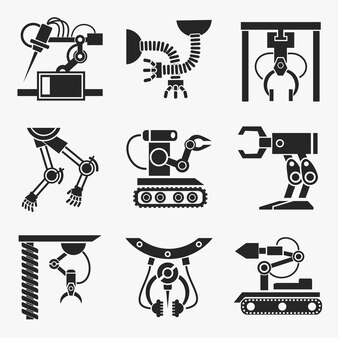Unleashing the Power of Robotics Movement: Revolutionizing Automation and Precision

In the world of robotics, movement is more than just a functional requirement—it's the heartbeat of innovation. Robotics movement technologies enable machines to perform complex tasks, mimicking the capabilities of human hands, legs, and even subtle muscular movements with astonishing accuracy. From industrial robots lifting heavy machinery to medical bots performing delicate surgeries, robotics movement is transforming industries. Let’s explore what drives these advancements and how they're redefining automation, precision, and adaptability across sectors.
Key Components of Robotics Movement
-
Actuators: Actuators are the mechanical devices responsible for converting energy into movement. They come in various types—electric, hydraulic, and pneumatic—each suited for different applications. Electric actuators, for instance, are widely used for their precision and ease of control, while hydraulic actuators are favored for high-power applications like construction robots.
-
Sensors: Sensors provide feedback, allowing robots to adapt to their environment and make decisions. Vision sensors, gyroscopes, and accelerometers help robots navigate, avoid obstacles, and perform tasks with precision. Advanced sensors can detect temperature, pressure, and even subtle variations in objects, giving robots a greater "awareness" of their surroundings.
-
Control Systems: Control systems act as the robot's brain, directing movement based on sensor inputs. From simple linear motion to complex multiaxis movement, control algorithms are essential in guiding the robot’s actions. Robotics engineers use sophisticated control techniques like Proportional-Integral-Derivative (PID) controllers, artificial neural networks, and fuzzy logic to ensure smooth and accurate motion.
-
Kinematics and Dynamics: Robotics movement also relies heavily on understanding kinematics (the study of motion) and dynamics (the study of forces). Engineers use these principles to design robots that can calculate the precise movement path, angle, and speed needed to perform tasks effectively. For instance, a robotic arm in a factory setting might need to move at specific angles and speeds to pick up objects without dropping or damaging them.
Types of Robotics Movement
-
Linear and Rotational Motion: The most basic types of movement are linear (straight-line) and rotational. Linear actuators are commonly used in conveyor systems, while rotational motion is key in robotic arms, where joints rotate to move the end effector.
-
Simultaneous Multi-Axis Motion: Many advanced robots require movement along multiple axes simultaneously. Industrial robots often have 6-axis freedom, allowing them to perform tasks that require high flexibility, such as welding or assembling intricate machinery.
-
Gaited Movement: In robots designed to walk, engineers study gaited movement. Bipedal robots like Boston Dynamics' Atlas require sophisticated algorithms to mimic human-like walking and balance, navigating various terrains and even climbing stairs.
-
Swarming and Coordination: Swarm robotics is a growing area where multiple robots work together to complete a task. Each robot in a swarm follows simple rules, but the collective behavior can lead to complex outcomes—ideal for applications like search and rescue, where swarm drones cover large areas efficiently.
Innovations Fueling Robotics Movement
-
Artificial Intelligence (AI) and Machine Learning (ML): AI and ML algorithms are pushing the boundaries of robotic movement. These technologies allow robots to learn from experience, adapting their movement patterns for more efficient performance. In robotics, reinforcement learning enables machines to optimize actions based on trial and error, which is particularly valuable in dynamic and unpredictable environments.
-
Soft Robotics: Traditionally, robots were made of rigid materials, limiting their flexibility. Soft robotics, inspired by nature, uses flexible materials that allow robots to bend, twist, and conform to their environment. This technology is especially useful in medical applications, where robots need to navigate sensitive and irregular surfaces without causing damage.
-
Bio-inspired Movement: Robotics engineers often look to nature for inspiration. For instance, robots are designed to mimic the crawling of a snake, the jumping of a grasshopper, or the swimming motion of fish. This bio-mimicry leads to robots that can adapt to various terrains and scenarios, from underwater exploration to planetary rovers.
Applications of Robotics Movement Across Industries
-
Manufacturing and Assembly: Precision robotics in manufacturing ensures quality and efficiency in assembly lines. Robots equipped with high-speed actuators can assemble products, weld, paint, and package with unparalleled speed and accuracy.
-
Healthcare and Surgery: Robotic-assisted surgery has gained traction due to its precision and minimal invasiveness. Surgical robots like the da Vinci Surgical System enable surgeons to perform delicate operations with tiny instruments, reducing recovery time and improving patient outcomes.
-
Agriculture: Autonomous robots are used in farming to plant seeds, monitor crops, and even pick fruits. By navigating challenging terrains and weather conditions, robots help farmers increase yield and reduce labor demands.
-
Space Exploration: Robotics movement is crucial in extraterrestrial exploration. Rovers like NASA's Perseverance need to navigate rough and uneven surfaces autonomously, collecting valuable data and samples. Advances in robotics movement allow for extended exploration in harsh and remote environments.
Future Trends in Robotics Movement
-
Autonomous Mobility in Dynamic Environments: Future robots are expected to navigate complex and unpredictable settings autonomously, from crowded urban areas to dense forests. Enhanced movement capabilities will support applications in disaster response, urban logistics, and autonomous delivery systems.
-
Human-Robot Collaboration: Robots are increasingly working alongside humans, particularly in factories and warehouses. Advanced movement capabilities and safety protocols are crucial to ensure seamless and safe collaboration between humans and machines.
-
Tactile Sensing and Adaptable Grip: Robots with tactile sensing abilities and adaptable grip mechanisms will soon handle objects of various sizes, shapes, and textures. These advancements will expand the range of tasks robots can perform, from handling fragile objects to providing care in elderly assistance.
Conclusion
The evolution of robotics movement is nothing short of transformative, pushing the boundaries of what machines can achieve. As robotics movement technologies continue to advance, they are poised to revolutionize various fields, making processes safer, faster, and more precise. From AI-driven control systems to bio-inspired designs, the journey of robotics movement has only just begun. In the near future, we can expect even greater strides, unlocking possibilities that were once the realm of science fiction.